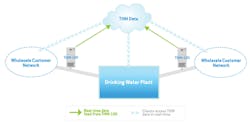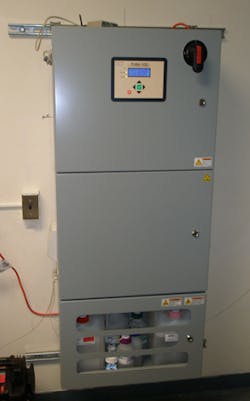Stage 2 DBPR: Understanding, Managing THM Formation is Key for Compliance in Consecutive Systems
By Rick Bacon
The buying and selling of treated water is common practice in the United States. Consecutive systems (CS) -- public water systems that buy or receive some or all of their finished water from one or more wholesale systems (WS) -- are responsible for serving nearly one-third of the water customers in the U.S.1
Prior to the promulgation of the Stage 2 Disinfectants and Disinfection Byproducts Rule (DBPR), most Safe Drinking Water Act (SDWA) regulations, including Stage 1 DBPR, did not specifically address consecutive systems. However, the newly-implemented Stage 2 DBPR includes monitoring and compliance requirements for consecutive systems with respect to disinfection byproducts (DBPs).
The Complexity of Combined Distribution Systems
The complexity of the relationship between wholesale and consecutive systems requires increased communication, collaboration and cooperation to meet the monitoring and compliance requirements of Stage 2 DBPR. Consecutive systems have limited control over the quality of water entering their distribution system and rely heavily on the wholesale system. As a result, both parties are urged to work together to evaluate and characterize the impact of distribution system operations on DBP formation.
If possible, purchasing agreements should be renegotiated to allow for water quality provisions, such as total organic carbon (TOC), finished water pH, secondary disinfectant residual, water age, and total trihalomethanes (THM) at exit and entry. At a minimum though, purchasing agreements should target total THM concentrations at the CS entry point and allow for reasonable growth within the CS distribution system.
Under Stage 2 DBPR, wholesale systems are not required to make treatment or operational modifications necessary to reduce DBP concentrations for consecutive systems, as long as the wholesale system meets their regulatory compliance requirements within their own distribution system. However, wholesalers are encouraged to optimize treatment plans to enhance DBP precursor removal and reduce DBP formation.
In some cases, it may be necessary for the consecutive system to implement treatment or operational changes to reduce distribution system DBP concentrations and comply with Stage 2 DBPR. While wholesale and consecutive systems are viewed separately from a regulatory perspective, their ability to comply with specific requirements is interconnected. As a result, it is important they work together to establish water quality goals that allow for each to comply with Stage 2 DBPR requirements.
Compliance Sampling & Monitoring in Combined Distribution Systems
Although not required by Stage 2 DBPR, coordination of compliance monitoring allows the wholesale and consecutive system to better understand DBP formation across the combined distribution system and help to formulate appropriate compliance strategies. Similarly, coordinating sampling schedules will help to identify changes in source, treatment or operation impacting DBP formation in each distribution system as it moves further from the treated water source.
Fluctuations in DBPs, more specifically THM levels, are difficult to characterize in combined distribution systems based on the frequency of quarterly grab samples and the turnaround time of external laboratory analysis. Results from external laboratory analysis are typically returned up to 10 business days later, at which point the underlying water quality parameters have changed and the treated water has already been delivered into the combined distribution system from the wholesaler to the consecutive system.
Role of Online THM Analyzers in Stage 2 DBPR Compliance
Technological advances to water quality instrumentation in recent years have led to the development of online colorimetric THM analyzers to proactively manage THM control and mitigation strategies. Online analyzers provide timely detail regarding THM formation in treated water, and their precision can be equivalent to or better than those of on- or off-site laboratories. As such, online THM analyzers are the perfect complement to THM control and mitigation strategies of combined systems.
Online THM analyzers help to characterize real-time DBP fluctuations throughout a combined distribution system, specifically noting where and when the THM variations occur. The use of an online analyzer, especially at predetermined water quality handover points across the combined distribution system, helps to highlight when contract compliance between a wholesaler and consecutive system is of concern. Timely resolution to these potential infractions is made possible through the use of online analyzers.
As wholesale and consecutive systems work to meet the requirements of Stage 2 DBPR, online THM analyzers play an important role in their compliance strategy. Online THM analyzers help optimize treatment processes, assist in monitoring water quality at handover points in consecutive systems, and reduce related expenses while ensuring Stage 2 DBPR compliance.
Case Study: Old Bridge Municipal Utilities Authority
The use of an online THM monitor helped the Old Bridge Municipal Utilities Authority (MUA) serving the Township of Old Bridge, Middlesex County, N.J., achieve DBP compliance.
MUA meets approximately 60 percent of its water treatment needs through the operation of two water treatment plants. The remaining 40 percent is purchased from the Middlesex Water Company and stored in a 10-million-gallon (MG) water storage tank.
In 2012, MUA began taking quarterly DBP measurements to comply with Stage 2 DBPR, administered by the New Jersey Department of Environmental Protection (NJDEP). NJDEP selected eight DBP test locations, all concentrated in the northwest region of the distribution system near the entry point of purchased water from Middlesex Water.
After two quarters of testing, three out of the eight test locations at MUA showed elevated levels of the DBP haloacetic acid 5 (HAA5). Meanwhile, test results from Middlesex Water continued to show quarterly DBP levels in compliance with Stage 2 DBPR. The varied test results implied a DBP compliance problem within the MUA distribution system and not Middlesex Water. As a result, MUA remedied the problem by draining, cleaning and installing a tank mixer into its water storage tank.
With the immediate DBP compliance problem resolved, the utility remained cognizant of the impact that varying water quality conditions from Middlesex Water would have within the MUA distribution system. While quarterly DBP measurements are necessary for regulatory compliance, they are inadequate for understanding the real-time and actual DBP levels within the water distribution system at any given moment. DBP levels can range significantly, even within the same day, due to temperature, water demand, pumping schedules, climate changes, rain events, and more.
After attending a seminar hosted by NJDEP to help utilities understand the impact of Stage 2 DBPR, Michael Roy, MUA staff engineer, was intrigued by an online THM analyzer presented by Aqua Metrology Systems (AMS). Although MUA had high concentrations of HAA5 in its distribution system, THM values are a good surrogate test for HAA5 values. As a result, Roy invited AMS to install its THM-100™ online analyzer in the northwestern region of the distribution system to monitor the surface water that Old Bridge was receiving from Middlesex Water.
The THM-100 analyzer was installed in April 2013 at the site of the 10-MG water storage tank and began to monitor the THM levels of the incoming surface water from Middlesex Water as well as the THM levels of the water leaving the tank. The installation was the first of its kind in the state of New Jersey. The automated online THM analyzer uses an approved "purge-and-trap" sampling method, followed by desorption into a chemical mixture that generates a colored product and time-resolved spectrophotometric analysis for detection and determination of THM levels.
Shortly after installing the online THM analyzer and establishing baseline THM data, MUA discovered that the incoming surface water from Middlesex Water could range from less then 40 μg/L to well over 100 μg/L over the course of a week. In fact, a correlation between incoming THM levels and the size and severity of local rainstorms became apparent. "Scheduled to take measurements every six hours, the THM-100 not only provided precise tracking of the changes in THM levels but also enabled a much greater understanding of how the environment, climate and particularly rainfall and residence time affected the THM values of the purchased water from Middlesex Water," said Roy.
As a result of the insight derived from the online THM analyzer, MUA negotiated with NJDEP to allow the authority to only receive water from Middlesex Water at the northwestern interconnection when THM levels of the incoming water stream were below 70 μg/L. If THM levels were above 70 μg/L, MUA would purchase the additional water at a second Middlesex Water interconnection within the township where the surface water could be adequately mixed with the authority's treated groundwater. Since this procedural change, MUA has remained in Stage 2 DBPR compliance. Effective THM monitoring through the use of online THM analyzers has helped manage the Authority's compliance with Stage 2 DBPR.
About the Author: Rick Bacon, CEO, Aqua Metrology Systems Limited, [email protected] or 408-523-1900
References
1. Chowdhury, Zaid K. et al. Evaluation of Disinfection Practices for DBP and Precursor Occurrence in Consecutive Systems. Water Research Foundation, 2009.


